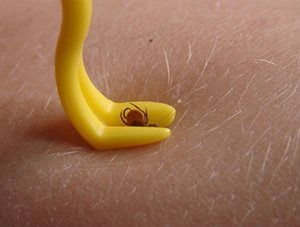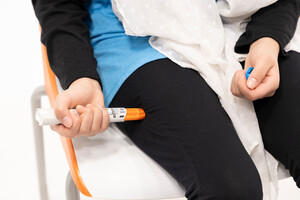The Public Health Agency of Canada warns that tick-borne diseases are likely to become more common in Canada due to climate warming and other environmental factors. As temperatures increase, the environment becomes more suitable for ticks and tick season lengthens.
Get the upper hand over bugs by knowing how to prevent insect bites and learn first aid steps for insect bites. Find out how to prevent tick bites and follow our step-by-step guide on tick removal. Understand the signs, symptoms, and response to anaphylaxis and get familiar with first aid steps for using an Epinephrine auto-injector, along with the appropriate First Aid to deal with insect bites.
To learn more about how to prevent and care for insect bites, take a Red Cross First Aid Course. Visit our First Aid Training page to learn more about first aid courses offered by the Canadian Red Cross and sign up for a course today. Our free, Red Cross First Aid App is available to download on the App Store and Google Play Store.

How to prevent insect bites
- Avoid wearing perfume, cologne, or other products with strong scents.
- Stay away from flowering plants, ripe fruit bushes and trees, rotten fruit, compost, and food waste.
- If this is not possible, wear long trousers and long-sleeved clothes, cover your hands, and wear protective netting over your face.
- Wear closed-toe shoes when walking outside, particularly on grass or flowering ground.
- Cover your drinks and food when you are outside and check them before drinking or eating.
- Wipe off any food from children’s clothes, hands, and faces, as it may attract bees or wasps.
- Before moving objects with your hands (such as containers that have been left outside), check underneath and inside them for insects that may bite or sting.
- Shake out shoes, socks, and clothing before putting them on, as they might contain insects.
- Do not touch or disturb bee or wasp hives. However, if you want to harvest honey, protect yourself by wearing long trousers and long-sleeved clothes and cover your hands and face as much as possible.
- Remain calm if you are attacked by a bee or wasp. Do not wave your hands to try to brush them away, since they react to movement.
- Run and find shelter if you are attacked by a swarm of insects.
First aid steps to follow for insect bites
- If the stinger is still in the person’s skin, scrape it away from their skin using a plastic card (such as a debit card).
- Wash the area with clean liquid. Some examples of clean liquid include:
- drinkable tap water
- soft drinks
- saline solution
- filtered or pre-boiled water
- Cover the area with an adhesive bandage.
- Cool the area to help control swelling. If you are using an object such as ice or a cold pack, put a thin, dry cloth or pad between the cold object and the person’s skin to avoid freezing the skin.
- Continue to watch for signs of infection, an allergic reaction, or anaphylaxis.
Follow these tips to help prevent tick bites
- Avoid wooded areas and areas with high grass and leaf litter.
- Walk in the centre of hiking trails.
- Limit how much skin is exposed:
- Wear long-sleeved shirts and long pants.
- Tuck your shirt into your pants and your pant legs into your socks or boots.
- Use insect repellents with 10 to 30% DEET on your skin and clothing if you will be in a grassy or wooded area or if you know that the tick population in the area is high. A child’s guardian or caregiver should apply the repellent for them, carefully avoiding their eyes, mouth, and hands.
- Use repellents sparingly, as one application will last four to eight hours. Heavier or more frequent applications do not make repellent more effective.
- Check gear and pets for ticks when you come in from outside.
- Immediately after being outdoors, do a head-to-toe check for ticks, using a hand-held or full-length mirror.
- Check your scalp, under your arms, in and around your ears, inside your navel, around your waist, behind your knees, and between your legs.
- If you are outdoors for an extended period, you should do this check several times during the day.
- A child’s guardian or caregiver should check them for ticks.
- Put outdoor clothing in a tumble dryer on high heat for one hour after coming back indoors to kill any ticks that might be attached to it.
- When walking with children in a tick-infested area, prevent ticks from entering their clothing by using a rubber band or tape to seal the area where their pants and socks meet.
How to remove a tick: Step-by-step guide

If the tick has not started to dig into the person’s flesh, remove it by brushing it off their skin.
If the tick has begun to bite the person:
- Remove any ticks that you find as soon as possible, before they become swollen with blood.
- Use tweezers to grasp the tick by its head, as close to the person’s skin as possible.
- Pull the tick upward slowly, steadily, and without twisting, until it lets go of the person.
- Wash the area with drinkable tap water if you have successfully removed the tick. The pressure of the running water lets it penetrate more deeply into the wound.
- If possible, save the tick in a resealable bag and record the date of the bite.
- You can either submit the tick to a public health laboratory for testing or bring it with you to an appointment with your care provider.
- Submitting ticks for testing helps public health officials track how ticks spread in Canada and what the risks of human exposure are.
- Live ticks can be stored for up to 10 days in the refrigerator. If the tick is dead, place it in the freezer instead.
If the tick’s mouthparts are in contact with the person’s skin, the tick can transmit diseases, which is why you need to remove the tick in one piece as quickly as possible. The best tool for removing a tick is a pair of fine-tipped tweezers or a special tick removal tool, such as a tick key.
Anaphylaxis: Know the signs, symptoms, and how to respond
Signs and symptoms of anaphylaxis may include:
- Difficulty swallowing.
- Tingling in a person’s mouth.
- Weakness or dizziness.
- Difficulty breathing.
- Airway narrowing; swelling of the lips, tongue, face, or throat that causes hoarseness or noisy breathing.
- Signs of shock.
First Aid Steps: Using an Epinephrine Auto-Injector

There are different types of auto-injectors available for anaphylaxis. Follow the instructions and directions located on the model being used.
Guide the person through these steps:
- Remove the safety cap from the epinephrine auto-injector.
- Firmly push the tip of the epinephrine auto-injector against the middle third of the outer thigh. You should hear a click. Epinephrine auto-injectors are designed to penetrate clothing, including denim.
- Hold it in place for up to 10 seconds. Gently rub the injection site for 30 seconds.
- If the person is not responsive and their breathing is abnormal, begin CPR.

